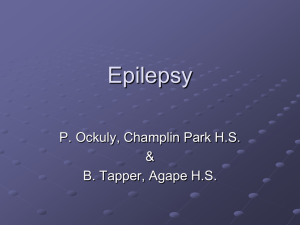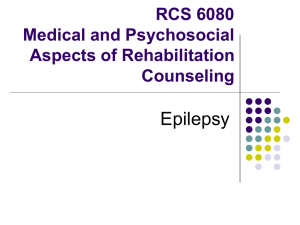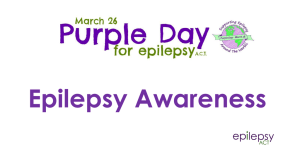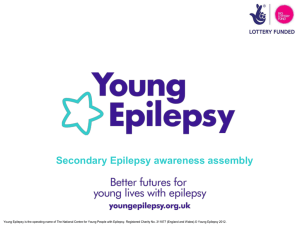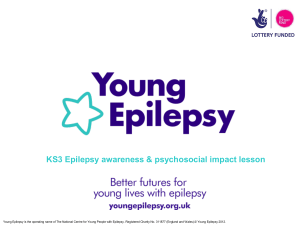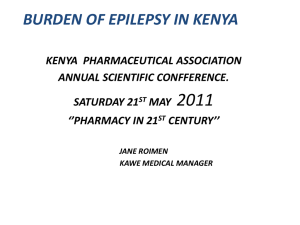KS3-Epilepsy-awareness-and-first-aid-lesson
advertisement
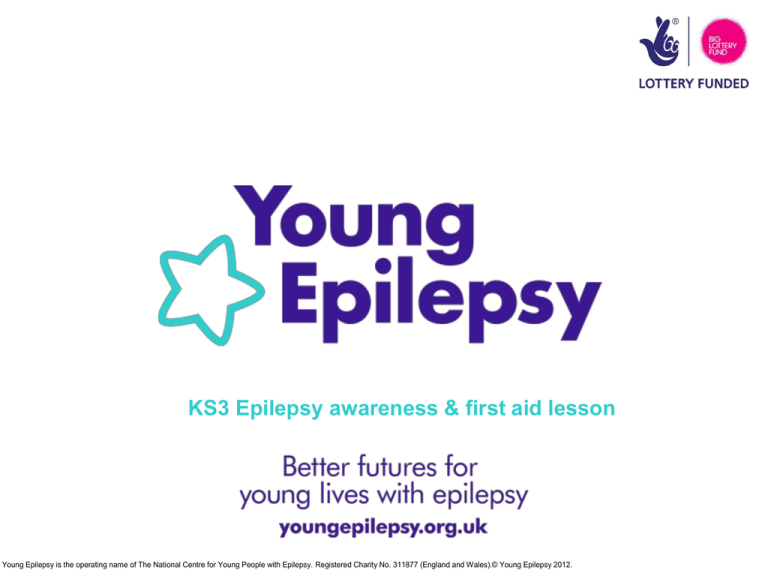
KS3 Epilepsy awareness & first aid lesson Young Epilepsy is the operating name of The National Centre for Young People with Epilepsy. Registered Charity No. 311877 (England and Wales).© Young Epilepsy 2012. Why does everyone need to know about epilepsy? Epilepsy is much more common than people realise 63,400 children aged 18 and under have epilepsy in the UK Epilepsy can take effect suddenly for a short time We can all help people with epilepsy to stay safe In epilepsy, what part of the body can suddenly become confused for a short time? The brain What does the brain do? How does our brain control our body? 1. The brain sends out an electrical message. 2. The electrical message moves through the body (with the help of neurons). 3. The electrical message reaches the hand and makes it move (by affecting muscles). Key point In epilepsy, there is a problem with the electrical messages in the brain. Key point People with epilepsy experience sudden bursts of electricity in their brain - called a SEIZURE. Seizures disrupt the way the brain works for a short time. What might it look like when someone has a seizure? Seizures Generalised Focal Focal seizures Absence seizures Key point Most people with epilepsy take medication everyday to help prevent seizures. Modelling a seizure Tonic clonic seizures Tonic (stiffening) Clonic (jerking) Key point During a seizure, we need to keep the person safe. Seizure first aid Do or don’t? Seizure first aid Do or don’t? Panic Seizure first aid Do or don’t? Call an ambulance immediately Seizure first aid Do or don’t? Send for help Seizure first aid Do or don’t? Put something soft under their head Seizure first aid Do or don’t? Time how long the seizure lasts Seizure first aid Do or don’t? Hold them down so they don’t hurt themselves Seizure first aid Do or don’t? Move them away from the chair to avoid injury Seizure first aid Do or don’t? Try to bring them around Seizure first aid Do or don’t? Put them on their side (in the recovery position) as soon as possible Seizure first aid Do or don’t? Stay with them until they are fully recovered and reassure them Time the seizure 1 Put something soft under their head 2 Keep the area safe 4 Stay calm and reassure 5 Put them into the recovery position AFTER the shaking has stopped 6 3 Get help Living with epilepsy Staying safe Be aware of the risks Talk to friends & family Do things to keep safe Dai Greene “I hope to inspire all young people that you can live a normal life with epilepsy and follow your dreams to do whatever you want. I’m lucky that my condition is not severe but I have learned to change my lifestyle and know my trigger points to stay away from seizures.” Key point People with epilepsy can join in most activities just like everyone else. Key points • In epilepsy, there is a problem with the electrical messages in the brain. • People with epilepsy experience sudden bursts of electricity in the brain - called a seizure. Seizures disrupt the way the brain works for a short time. • Most people with epilepsy take medication every day to help prevent their seizures. • During a seizure, we need to keep the person safe. • People with epilepsy can join in most activities just like everyone else. KS3 Epilepsy awareness & first aid lesson Young Epilepsy is the operating name of The National Centre for Young People with Epilepsy. Registered Charity No. 311877 (England and Wales).© Young Epilepsy 2012.
